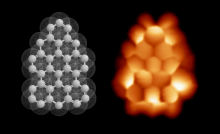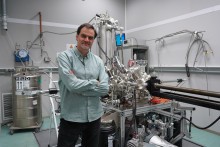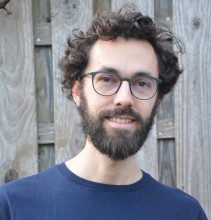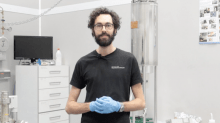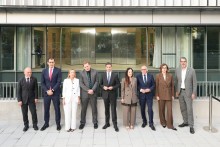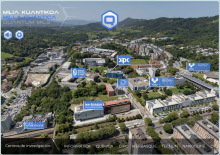Related news by tag Quantum-Probe Microscopy
Students from UPV / EHU, Tecnun, UAB and the UB carry out summer internships at CIC nanoGUNE
On Tuesday, 19 June, we welcomed a group of internship students that will carry out a research project at NanoGUNE during the summer. The director of the center, Jose M. Pitarke, received the students with a presentation talk about nanoGUNE, that was also attended by the researchers that will conduct the students’ projects.
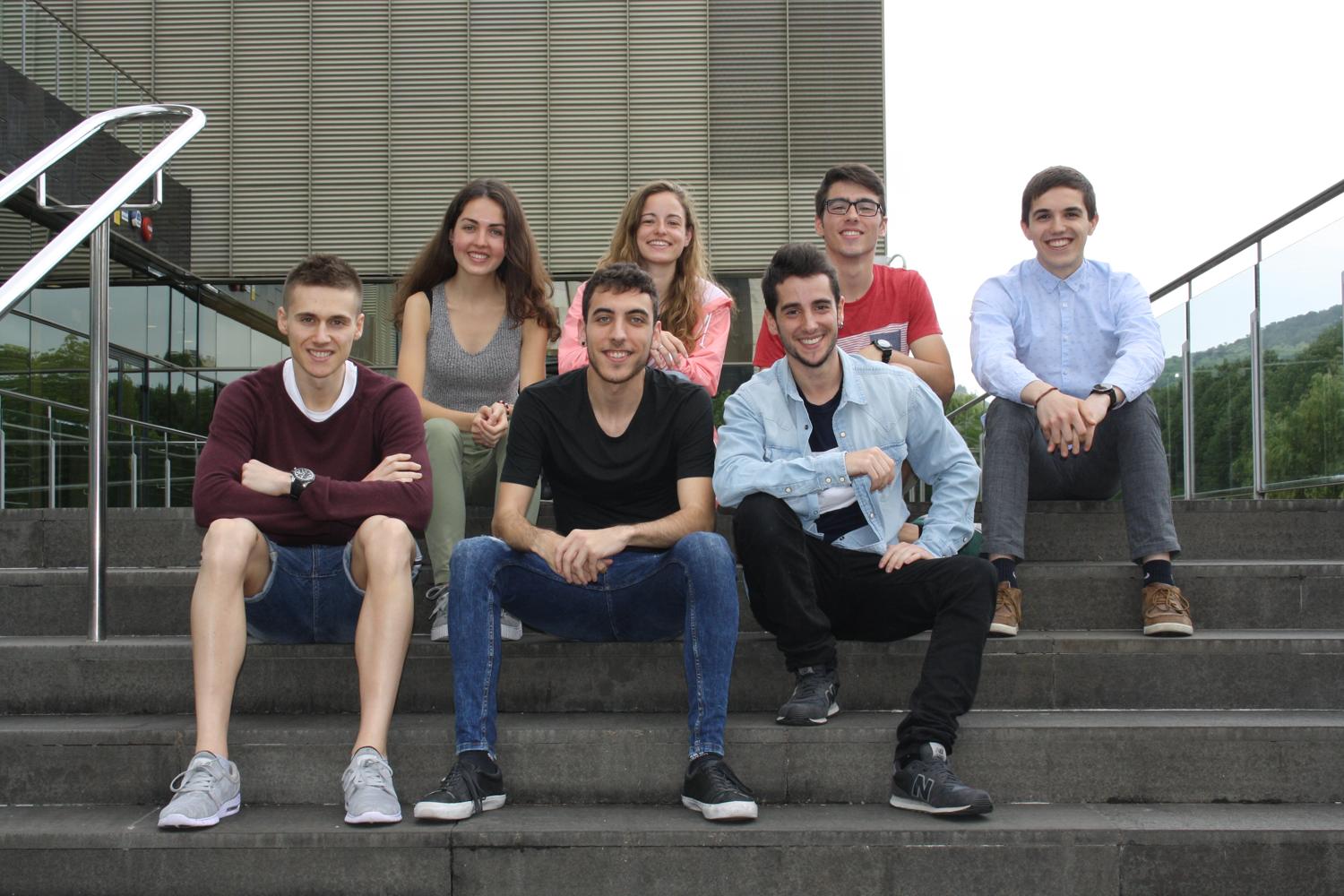
The 11 students come from different universities, among which are, Unibersity of the Basque Country (UPV /EHU), Tecnun, Univeristy of Barcelona (UB), Autonomous University of Barcelona (UAB). This program offers to the students a real experience of work in a research laboratory in order to make it easier for them to take decision about their future professional life.
The students will collaborate and learn with the different research groups at nanoGUNE, such as nanooptics, nanodevices or nanomagnetism. They will carry out a research project for two months following the instructions of a researcher of their group.
Some of them started the internships at the beginning of the month and they have been very involved in the group’s work. "The truth is that we started very suddenly; the very first day they took me to the laboratory," says Amaia Ochandorena, a student of Biochemistry and Molecular Biology at the UPV/EHU.
All the students knew CIC nanoGUNE and stressed that "it is an important research center" and "offers and works with topics of much interest".
For these students, and also for undergraduate students of general, nanoGUNE offers the possibility of collaborating with the center for the completion of final graduate or master thesis projects, for which also opens a call for grants every year.
Nanomagnets made of graphene for faster and more sustainable information technologies

The meeting marks the starting point of a 4-year research project that is coordinated by CIC nanoGUNE and integrates IBM Research, Donostia International Physics Center, and University of Santiago de Compostela, Technical University of Delft and the University of Oxford. The consortium of these 6 leading European research institutions has been granted a total of €3.5 million from the European Commission under the highly competitive Horizon 2020 FET-Open call, which funds cutting-edge high-risk / high-impact interdisciplinary research projects that must lay the foundations for radically new future technologies.
The SPRING project combines recent scientific breakthroughs from the consortium members to fabricate custom-crafted magnetic graphene nanostructures and test their potential as basic elements in quantum spintronic devices. The targeted long-term vision is the development of an all-graphene – environmentally friendly – platform where spins can be used for transporting, storing and processing information.
The spin is an intrinsic property of electrons that makes them behave like tiny magnets. For instance, every electron in any material carries both a charge and a spin, the latter playing a key role in magnetism.
Within the scientific community there is consensus that spin is the ideal property of matter to expand the performance of current charge-based nanoelectronics into a class of faster and more power-efficient components, being the basis for the emerging technology called quantum spintronics. The SPRING project will investigate the fundamental laws for creating and detecting spins in graphene, this is to read and write spins, and using them to transmit information.
Jose Ignacio Pascual, Ikerbasque Research Professor at CIC nanoGUNE and scientific coordinator of the project, explains that “graphene is ideal to host spins and to transport them. This atomically thin material can now be fabricated with atomic precision, opening the door to fabrication of designer structures with precise shape, composition, spin arrangement, and interconnected by graphene electrodes for electrostatic or quantum gates. The potential is a platform for the second quantum revolution as qubit elements for quantum computation.”
nanoGUNE launches a new summer internship call for university students
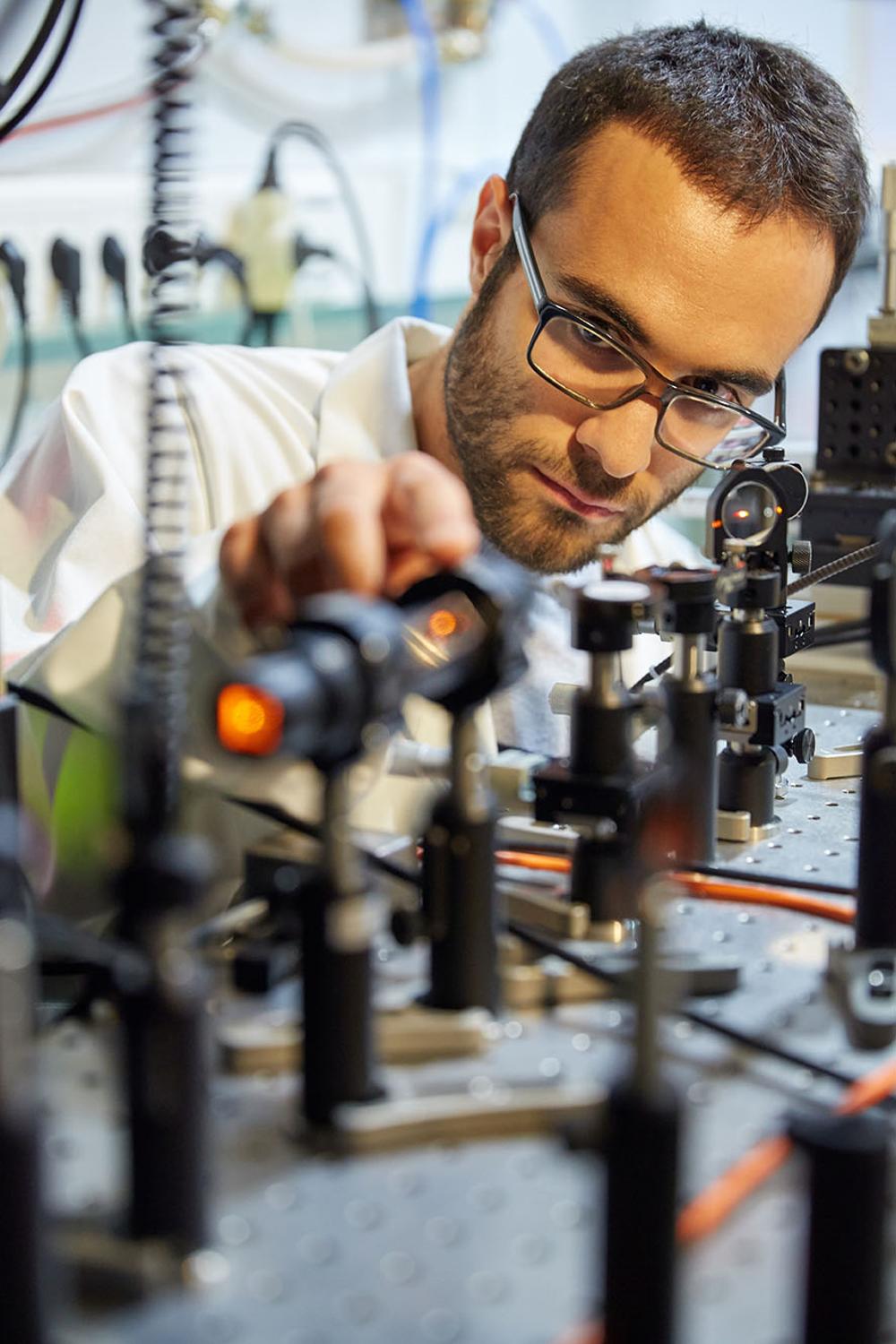
Through this programme the Basque nanoscience research centre will this summer be receiving about ten new students in their 3rd and 4th years of Physics, Chemistry, Biology and Engineering. For a period of six weeks or two months the young students will be collaborating with nanoGUNE researchers in their research projects on subjects such as electron/spin phenomena and magnetism, nanoscale optics, nanoscale materials and nanobioengineering, among others.
To participate in the summer internship programme any students who are interested will need to submit their applications online via the nanoGUNE website, the deadline being 16 February. Full information relating to the call is available via the nanoGUNE website (www.nanogune.eu)
A window on the invisible
When working at the atomic scale, matter behaves differently and physics reveals interesting situations. Yet all this entails very important technical requirements. nanoGUNE’s Nanoimaging Group gathers the technical—three huge microscopes— and human resources to put all this into practice.
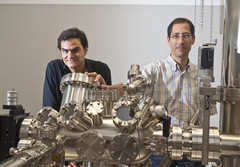
“The properties of materials depend on those of the atoms that form them and on how the atoms are arranged. We aim to research the properties of the atoms individually or in nanostructrues, and to design strategies to assemble them in new materials that optimize their behaviour in a wide range of functionalities like electronics, magnetism or catalysis,” explained José Ignacio Pascual, head of nanoGUNE’s Nanoimaging Group. Some of the applications that could result from the research being done by this group are future electronic devices developed using new materials.
Three in one
José Ignacio Pascual’s research group has designed and built one of their three microscopes. This microscope has the unique capability of measuring electronic, mechanical and optical properties at the atomic scale. The microscope, which has been functioning since January in one of the labs in the basement at nanoGUNE, also allows atoms and molecules to be moved around one by one.
The microscope uses a very sharp tip as a probe to get close to an atom or molecule on a surface and to measure the tunnel current, electrons that jump from the tip to the sample. These electrons fulfil the function performed by light on a larger scale: they allow us to see the atoms and find out their properties.
This microscope operates in extreme temperature and vacuum conditions. That is because at room temperature, atoms have lots of energy and do not stop moving, so it would be impossible to study and manipulate them one by one. That is why Pascual’s group has had to couple the microscope to a tank of liquid helium, a helium cryostat, to work at 269 degrees below zero. The cold temperature is indispensable for keeping the atoms still. And the vacuum is also fundamental to prevent the air, which is also made up of atoms, from distorting the measurements. So work is done with what is known as ultra-high vacuum, 10-13 atmospheres, the equivalent of the intergalactic vacuum.
And it doesn’t stop there. This first microscope is even more unusual. It allows to work with materials that do not conduct electricity, thanks to the fact that José Ignacio Pascual’s group has connected the tip to a small quartz tuning fork. The tuning fork causes this machine not only to work as a tunnel effect microscope, but also as an atomic force microscope. That way the force with which atoms are attracted to each other can be measured, which is essential for studying the hardness of nanomaterials.
Towards electronics of the future
A second tunnel effect microscope, also located in one of nanoGUNE’s labs, works at even lower temperatures: only one degree from absolute zero or, in other words, at 272 degrees below zero. This microscope makes it possible to study problems relating to magnetism in individual atoms. “Atoms are like small magnets whose poles are randomly orientated, and part of our work consists of studying how they are arranged”, said Pascual. “It is an absolutely basic subject of research which has implications in the field of nanotechnology. If we can control the magnetism of atoms one by one, we can reach the limits of matter in the field of information storage. One of the possible applications in the long term would be quantum computing which would allow information to be processed at much higher speeds,” he added.
An adjacent laboratory houses the third atomic force microscope. It is a collaborative tool that “allows to study larger systems that do not require the conditions of cold and vacuum needed to work on individual atoms,” explained Pascual. With this instrument the Nanoimaging group will be contributing its experience in microscopy to the other groups in nanoGUNE, thus expanding its original field of research to the fields of nano-optics, nanomaterials, nanodevices and many, many more.
The work of Pascual’s group is focussing on exploring the fundamental limits of science to spread knowledge and establish the bases for future technology. “What is more, there are technological products directly related with the instruments used in our research and which could be developed here,” added José Ignacio Pascual.
José Ignacio Pascual
José Ignacio Pascual-Chico (Madrid, 1968) is an Ikerbasque Research Professor and leads nanoGUNE’s Nanoimaging group. He has a PhD in Physics from the Autonomous University of Madrid. He was at the Fritz Haber Institute of the Max Planck Society and at the Institute of Materials Science in Barcelona, before arriving in Berlin. He spent a total of 12 years in Berlin, the last eight as Professor at the Freie Universität Berlin. He came to nanoGUNE in September last year to pursue his professional career.
CIC nanoGUNE
The CIC nanoGune Cooperative Research Center located in Donostia-San Sebastian (Basque Country) is a research center set up with the mission to develop basic and applied research in nanoscience and nanotechnology; it does so by encouraging the high level capability and training of researchers in this field, and by fostering cooperation among the various agents in the Basque Science, Technology and Innovation network (universities and R&D centers) and between these agents and industry.
Unraveling the magnetism of a graphene triangular flake
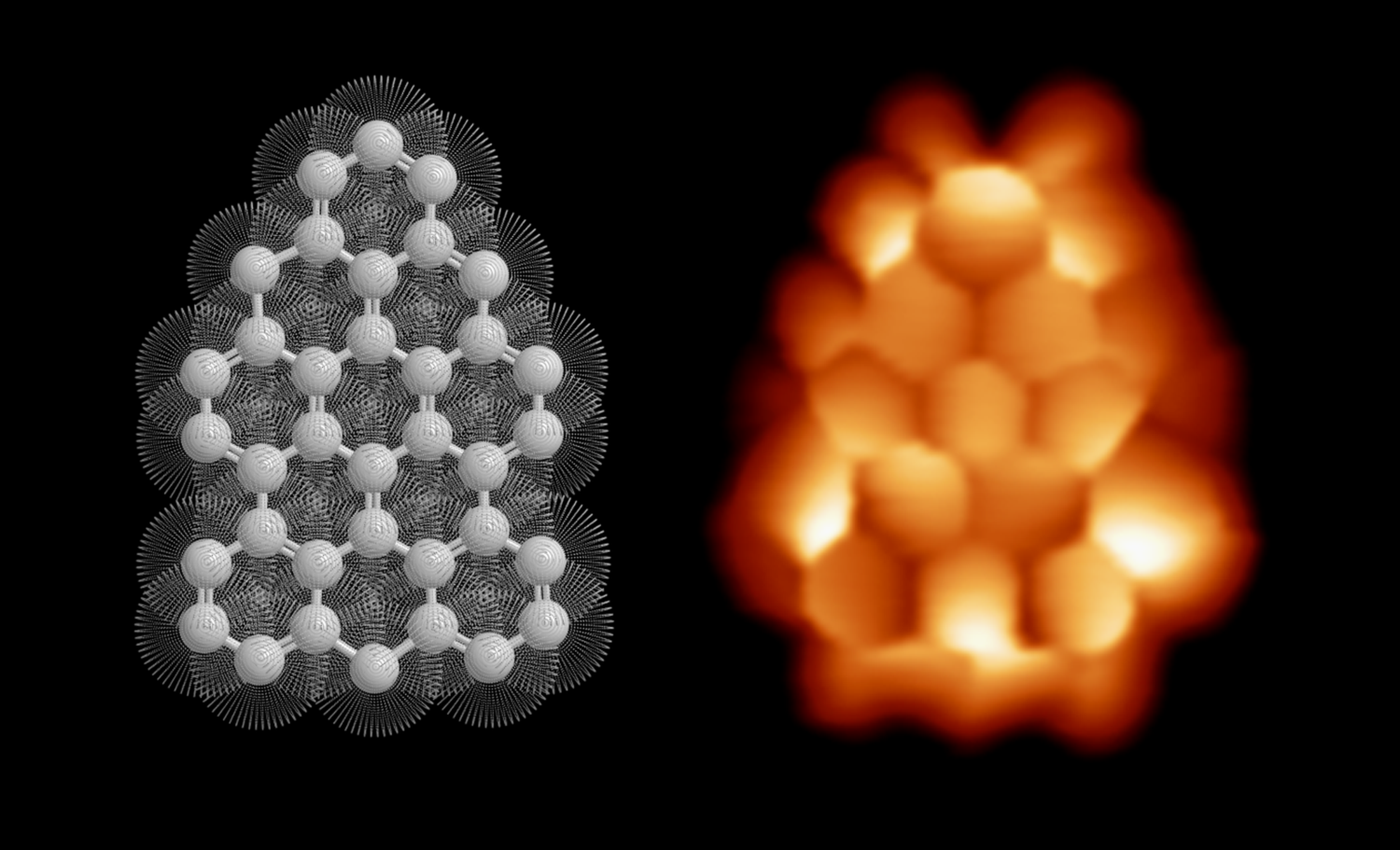
In a new study, published in Physical Review Letters [1], this challenge was revisited using a scanning tunneling microscope (STM). After assembling a triangular-like piece of graphene on a clean gold surface, high-resolution scanning tunneling spectroscopy measurements revealed that this compound has a net magnetic state characterized by a spin S=1 ground state and, therefore, that this molecule is a small, pure carbon paramagnet. These results are the first experimental demonstration of a high-spin graphene flake.
The findings were further complemented with atomic manipulation steps of hydrogen-passivated triangulene side-products occasionally found in the experiment. By controlled removal of these additional hydrogen atoms in the experiments, the spin state of the flake could be modified from a closed-shell, doubly hydrogenated structure, to an intermediate S=1/2 spin state, and finally to the high-spin S=1 state of the ideal molecular structure.
The experimental proof of a spin-state in the absence of a magnetic quantization axis (detectable by spin-polarized STM) or magnetic anisotropy (detectable by spin-flip inelastic tunneling spectroscopy) is not simple. In this work, the spin signature was obtained from the underscreened Kondo effect – an exotic version of the standard Kondo effect described in the 1960s – that can arise in high-spin systems. Its observation in a graphene flake on a metal has not been reported before and brings here novel insights to understanding spins interacting with surfaces.
The work was the result of a fruitful collaboration between theoretical and experimental groups at the Donostia International Physics Center (DIPC) and CIC nanoGUNE, both research institutes in San Sebastian, as well as an organic synthesis group at CiQUS, in Santiago de Compostela.
A fresh step towards quantum computing
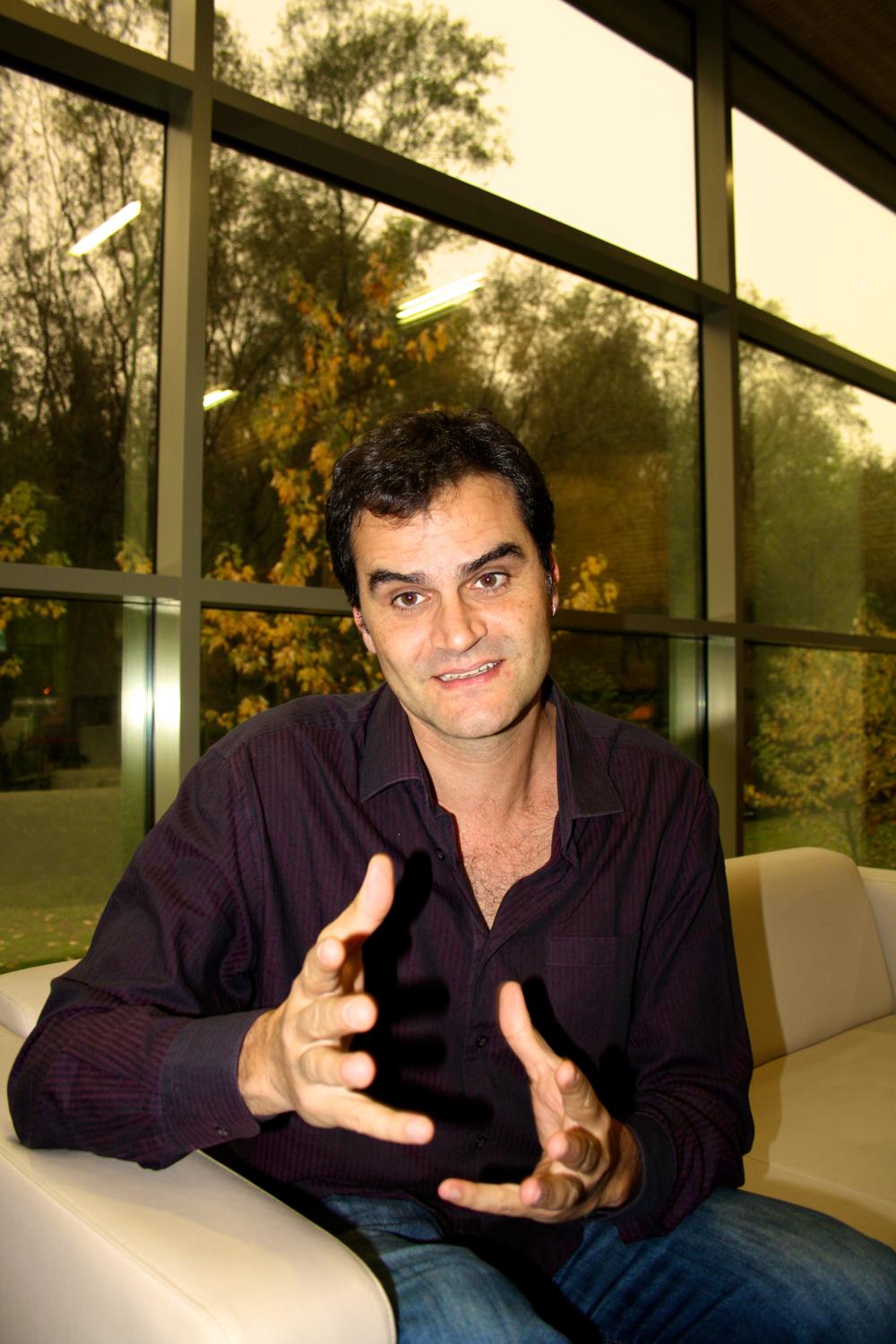
Advances in technology for computation and information storage always require to make the systems smaller and faster. The limits of miniaturization are those set by nature: Materials are composed by specific units, the atoms, that cannot be further divided. The question arising is: Can we still codify information at the atomic scale? And the answer is yes, we can! but one needs to manipulate a property of the atoms, individually, and keep them in that state there for sufficiently long time to be able to read it. One of the aims of the Ikerbasque researcher José Ignacio Pascual of nanoGUNE and his collaborators at the Free University of Berlin is to explore under which conditions one can write and read information by manipulating the magnetism of atoms. By studying the behaviour of tiny magnetic molecules in contact with a superconductor surface they have shown that it is possible to find a regime in which the superconductivity of the surface “assists” the magnetism of the atom and facilitate the processes of writing and reading its magnetic state. The study is contributing towards the ultimate goal of computation with individual atoms, as it shows that it is possible to manipulate the magnetic state in which an atom finds itself and make the latter last long enough to be “read”. The work has been published recently in the prestigious journal Nature Physics.
Magnetism and superconductivity are two highly complex properties of materials that are used in many technological applications in fields as wide-ranging as information computation and storage, medicine, transport, etc. Magnetism, the property that causes magnets to stick to iron, for example, is determined by a property of atoms known as ‘spin’. Put simply, the spin causes each atom to behave like a tiny magnet.
Atom spin tends to be “pointing” in a specific direction, which depends on how the atom interacts with its surroundings. The challenge of computation with spins is therefore about controlling this orientation by using electrical impulses as a method for encoding a piece of data. “One of the problems we come up against is that the spin lasts very little time in this new position. The interaction with its surroundings ends up dominating it and it very quickly returns to its original position. If we want to use it to store information, we need to be able to guarantee that it will remain longer in the position we give to it,” explains José Ignacio Pascual. “It is as if we were to raise a hand to ask permission to speak; our natural state is to be with our hands by our sides so we have to be capable of keeping a hand raised long enough so that our message can get through,” added the nanoGUNE researcher.
Spin under control
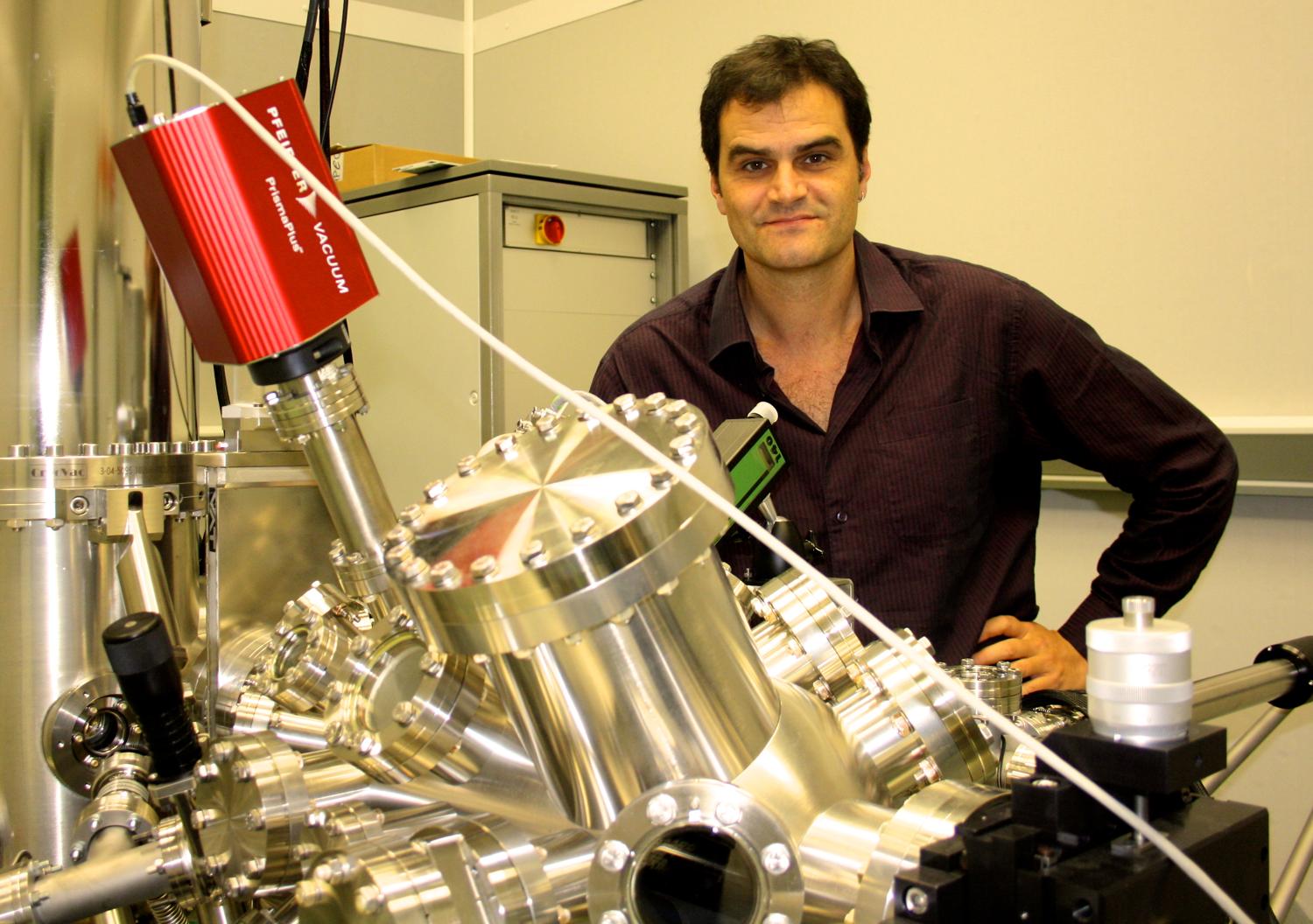
In this respect, the researchers have shown that superconductivity can help a spin to remain in the correct position longer. The main difficulty has been to get magnetism and superconductivity to coexist, because the magnetism interacts with the electrons of the superconductor and destroys this property. To avoid this to happen, the researchers have protected the magnetic atoms by means of an organic covering. “If we put the same atoms in place without any kind of protection, the superconductivity will automatically disappear around the atom,” points Pascual.
Once the coexistence of the two properties was achieved, experiments have shown that in a superconductor it is much easier to read the modified state of spin, because this new state lasts much longer. “In a superconductor the electrons are paired off, a property that is crucial for keeping the spin going for longer in the orientation we bring about, so that we can read it with electric currents,” he explains. The superconductor used was lead and to write and read the state of spin they used an ultra-cold tunnel-effect microscope at a temperature of –272ºC. “Our measurement showed that the spin of the magnetic atom placed in a superconductor lasts 10,000 times longer than in a normal conductor,” stresses the nanoGUNE researcher. These results will drive forward the exploration of new methods of information storage and computation on an atomic scale, in other words, what is known as quantum computing.
José Ignacio Pascual
José Ignacio Pascual-Chico (Madrid, 1968) is an Ikerbasque Research Professor and leads nanoGUNE’s Nanoimaging group. He has a PhD in Physics from the Autonomous University of Madrid. He was at the Fritz Haber Institute of the Max Planck Society and at the Institute of Materials Science in Barcelona, before arriving in Berlin. He spent a total of 12 years in Berlin, the last eight as Professor at the Freie Universität Berlin. He came to nanoGUNE in September last year to pursue his professional career here.
CIC nanoGUNE
The CIC nanoGune Nanoscience Cooperative Research Centre, located in Donostia-San Sebastian (Basque Country), is a research centre set up with the mission to develop basic and applied research in nanoscience and nanotechnology; it does so by encouraging the high level capability and training of researchers in this field, and by promoting cooperation among the various agents of the Basque Science, Technology and Innovation Network (universities and R&D centres) and between these agents and industry.
Publication reference
Registration period for the summer internship program open
CIC nanoGUNE has just launched the program for summer internships, which runs every year. University students are offered the chance to get involved in the activity of a world-class research center.
nanoGUNE Scholarship: call for Master Thesis students

The Scholarships will be of a total amount of 3,000€. This amount is for the whole period and will not be compatible with any other grant or funding awarded for the same purpose. Candidates have to be pre-registered and accepted at the above mentioned Master degrees in order to be eligible for these grants. Interested candidates can find all the information about the offered master projects and the application process following this link.
Besides the grants, nanoGUNE offers Master students coming from any official Master degree the possibility to develop their Master Thesis within one of its research groups.
Physicist Nacho Pascual receives ERC Advanced Grant to develop new quantum materials
The prestigious ERC Advanced Grants are the highest recognition of scientific excellence in Europe. They provide long-term funding to support the brightest researchers and their teams while they pursue high-risk, high-benefit innovations in any field of research. The only evaluation criterion required by the European Research Council is the scientific excellence of the project and its research staff, which puts Nacho Pascual at the forefront of European scientific research.
Atomic magnets using hydrogen and graphene
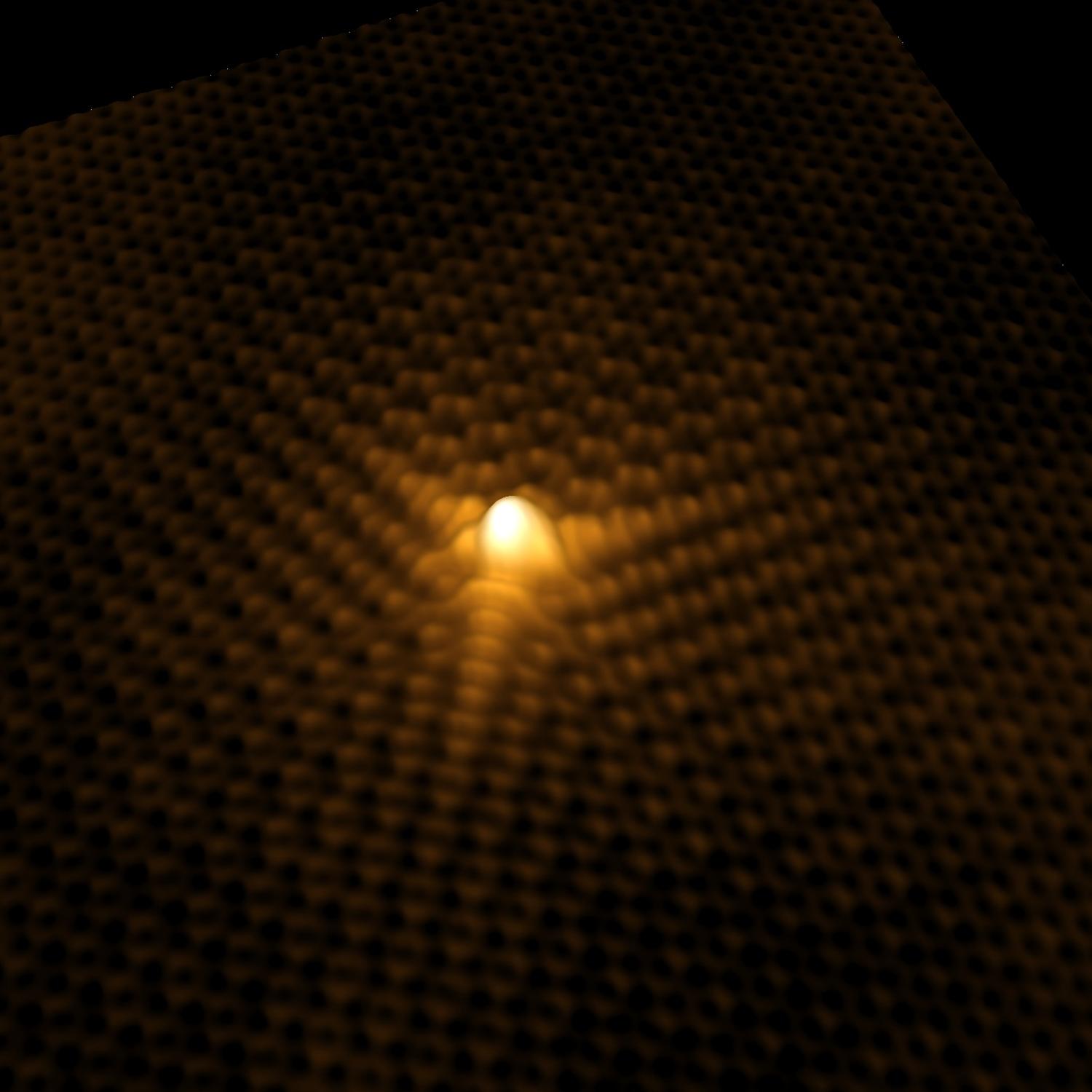
Graphene, a sheet one atom thick made up of carbon atoms, has a huge number of qualities but lacks magnetic properties. Yet the hydrogen atom has the smallest magnetic moment. The magnetic moment is the magnitude that determines how much and in what direction a magnet will exert force. “In other words, we can all remember having held a magnet in our hands and seeing how it was capable of attracting or repelling another magnet at a certain distance, which was greater or smaller depending on its power. Well, what really determined this behaviour was the magnetic moment of our set of magnets. The distance at which we began to feel the appearance of a force was specified by the spatial extension of their magnetic moments, and the fact that the force should attract or repel depended on the relative orientation between them; that is why when one of the magnets was turned round, they then attracted or repelled each other or vice versa,” explained Miguel Moreno Ugeda, Ikerbasque Fellow at nanoGUNE.
“Our work reveals how when a hydrogen atom touches a graphene layer it transfers its magnetic moment to it," said Moreno. “In contraposition to more common magnetic materials such as iron, nickel or cobalt, in which the magnetic moment generated by each atom is located within a few tenths of a nanometre, the magnetic moment induced in the graphene by each atom of hydrogen extends several nanometres, and likewise displays a modulation on an atomic scale,” he added. The experiments were carried out with the help of a tunnel-effect microscope. This microscope allows matter to be imaged and manipulated on an atomic scale. Likewise, the results show that these induced magnetic moments interact strongly with each other at great distances (compared with the atomic scale) while also abiding by a particular rule: the magnetic moments are added or neutralised depending critically on the relative position between the absorbed hydrogen atoms. What is more, and of equal importance, is that “we have managed to manipulate the individual hydrogen atoms in a controlled way, and this has enabled us to freely establish the magnetic properties of selected regions of graphene,” stressed Moreno.
In the quest for magnetism
Ever since 2004 when it was first possible to obtain graphene, laboratories across the world have been trying to add magnetism to the long list of properties of this purely two-dimensional material. This interest arises mainly out of the fact that graphene is, a priori, an ideal material for use in spintronic technology. This promising technology is aiming to replace traditional electronics by transmitting both magnetic and electronic information at the same time, which could give rise to a new generation of more powerful computers. So “the results obtained in this work, which indicate the possibility of freely generating magnetic moments in the graphene and showing how these moments can communicate with each other over great distances, are paving the way for a promising future for this material in the emerging field of spintronics,” concluded Moreno.
Video explaining the results of the research in a didactic way:
Niklas Friedrich gets GEFES 2023 Award for best experimental thesis
Molecular spintronics is a technology that aims to use the electron spin of organic molecules as the basic unit of information. This thesis studies electronic transport through graphene nanoribbons (GNRs) and demonstrates electronic access to spin states created by special units embedded in GNRs.
The intermediates in a chemical reaction photographed ‘red-handed’
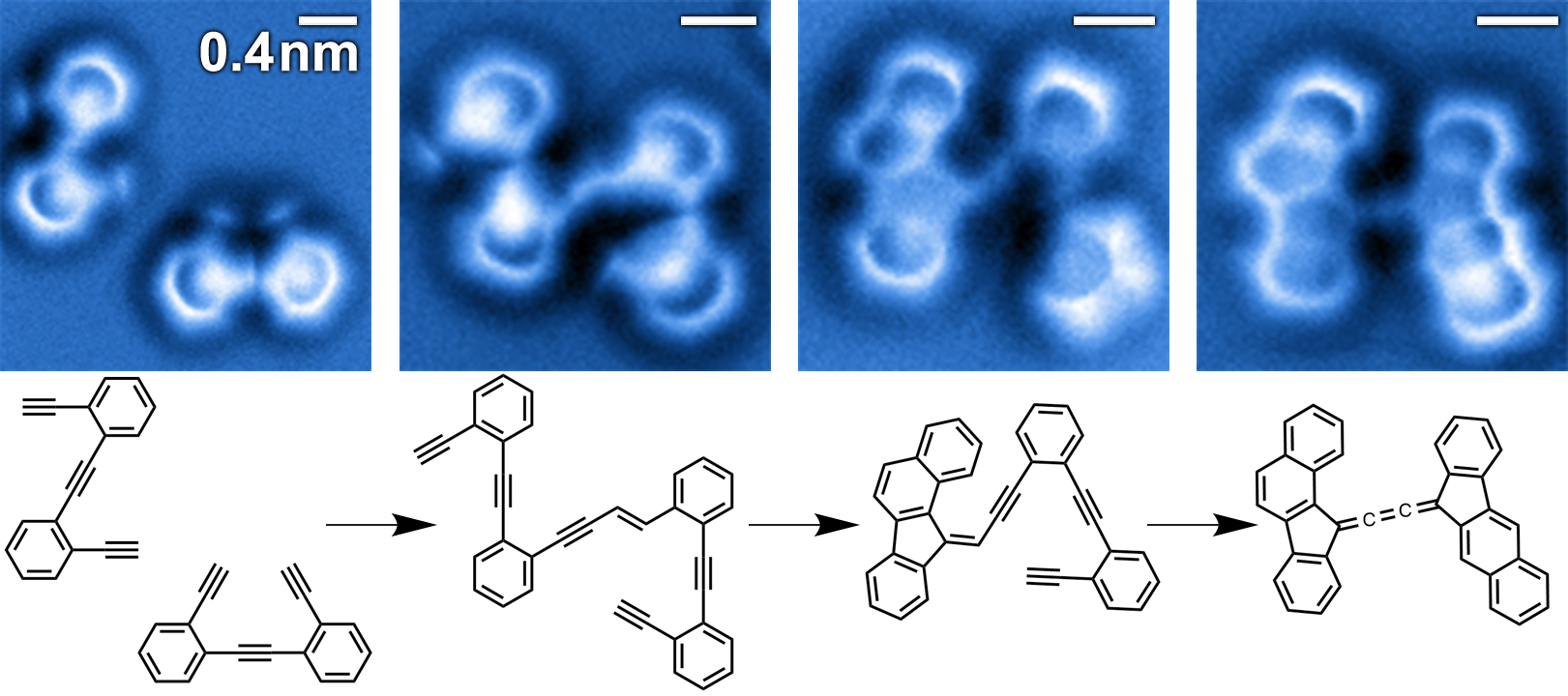
One of the long-standing goals being pursued by chemists has been to succeed in following and directly visualising how the structures of molecules change when they undergo complex chemical transformations.
Reaction intermediates, which are highly unstable substances that form in different steps in a reaction before the products are obtained, are particularly difficult to identify and characterise owing to their short lifetimes. Getting to know the structure of these intermediate species may be very helpful in understanding the reaction mechanisms and, what is more, could have a great impact on the chemical industry, materials science, nanotechnology, biology and medicine.
In the framework of this international collaboration, the bond configuration of the reactants, the intermediate and final products of a complex, organic reaction have been imaged and resolved at the single-molecule level. The prestigious journal Nature Chemistry has published this research in its latest issue.
The team has obtained the images of the chemical structures associated with different steps in the reaction cascade involving multiple steps of enediyne molecules on a silver surface, using non-contact atomic force microscopy (nc-AFM) with a particularly sensitive tip: it uses a very fine needle that can detect the smallest bumps on an atomic scale (in a way not unlike reading in Braille) as it absorbs a carbon monoxide molecule that acts like a “finger” on the text to increase its resolution.
Stabilizing the intermediates
By combining the latest advances in numerical calculus and the classical analytical models that describe the kinetics of sequential chemical reactions, an area that explores the speed of the reactions and the molecular events taking place in it has been proven. So to explain the stabilization of the intermediates, it is not enough just to consider their potential energy, it is essential to bear in mind the energy dissipation and the changes in molecular entropy, which measures how far a system is organised. The surface, and in particular the interaction of the extremely unstable intermediates with the surface, play a key role for both the entropy and the dissipation of energy, which highlights a fundamental difference between the surface-supported reactions and gas-phase or solution chemistry.
Additional information
The research has been carried out by various research groups led by Felix Fischer, Michael Crommie, and Angel Rubio (University of California at Berkeley, Lawrence Berkeley National Laboratory, EHU, and Max Planck
Institute for the Structure and Dynamics of Matter in Hamburg), and by Ikerbasque researchers Dimas Oteyza (CSIC/EHU and DIPC) and Miguel Moreno Ugeda (CIC nanoGUNE).
NIKLAS FRIEDRICH GETS RSEF-EPJ+ AWARD FOR BEST EXPERIMENTAL PHD THESIS
Niklas Friedrich from nanoGUNE’s Quantum-Probe Microscopy group has obtained the RSEF-EPJ+ Award due to his experimental PhD thesis entitled “Electronic Transport through Suspended Graphene Nanoribbons Using a Scanning Tunneling Microscope”.
Summer Internship Program: call open until 5 February

NanoGUNE has just opened the registration period for the Summer Internship Program.
This year, we offer up to 13 projects for university students in the 3rd and 4th year of Physics, Chemistry, Biology, Engineering, and Mathematics. They will have the chance to get a closer look at the activity taking place at a cutting-edge research center for between six weeks and two months during the summer. This experience enables university students to collaborate with nanoGUNE researchers on their research projects in a whole range of fields, such as nanomagnetism, self-assembly, nanobiomechanics, nanodevices, nanomaterials, nanoimaging, and nanoengineering.
All the information about these projects, timetables, pay, etc. can be checked out at: https://www.nanogune.eu/summer-internship
Anyone interested in participated in the selection process needs to send an email attaching his/her academic record and CV to the address provided on the webpage no later than 5 February 2017. The students selected will be asked to attend an interview on 17 or 24 February.
Inauguration of IBM-Basque Country quantum computer in Donostia
The round table brought together internationally renowned experts such as Christopher Berzins (Embassy of Canada in Spain), Asier Areitio Ibarluzea (Basque Government), Román Orús Lacort (DIPC and Multiverse Computing S.L.), Toshiyasu Ichioka (RIKEN), and Miren Ainhoa Aizpuru Murua (BIC Gipuzkoa). The session was moderated by Juan Antonio Zufiria Zatarain (Bankinter Foundation for Innovation and Spanish Royal Academy of Engineering).
Future materials are becoming 'topological’
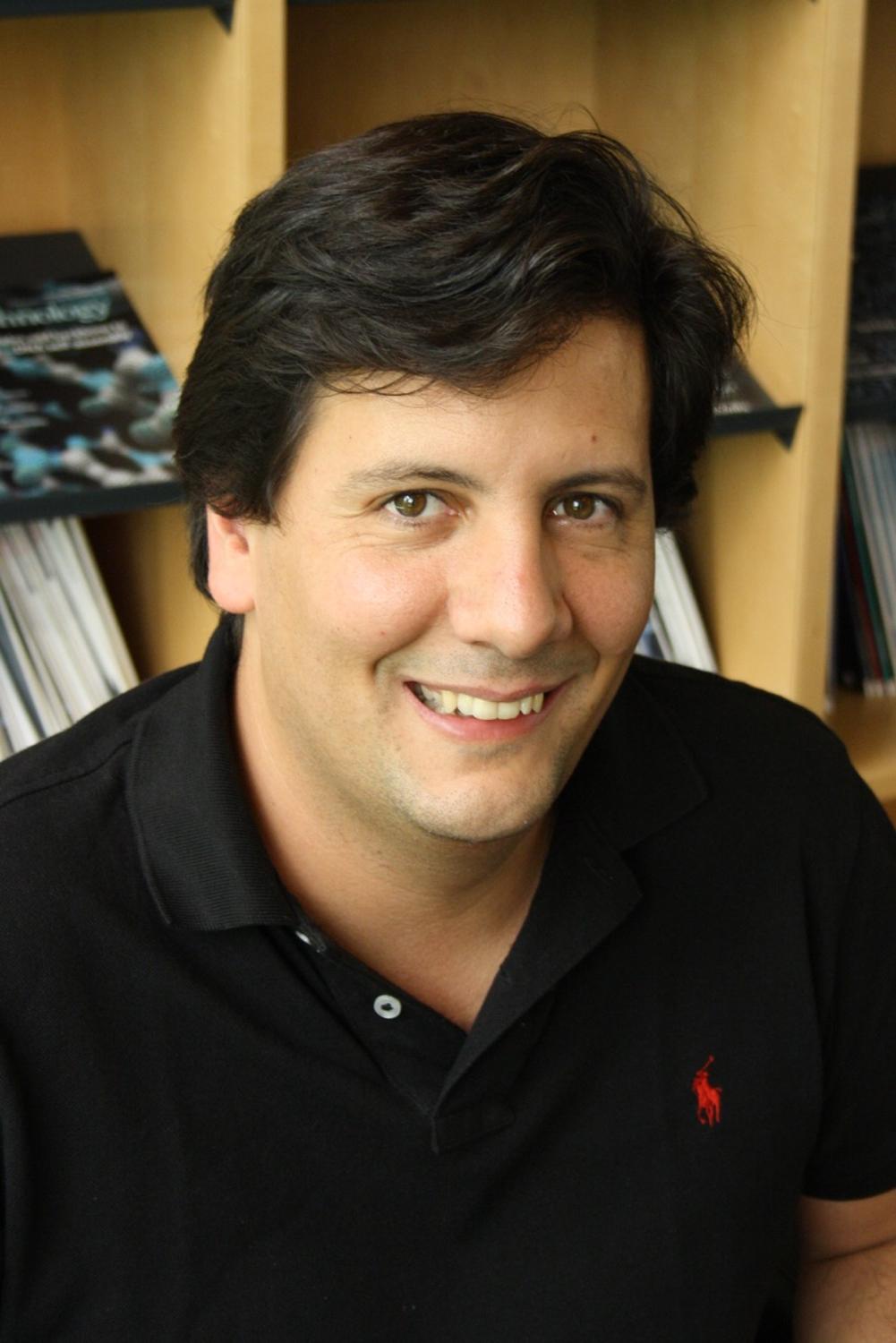
Ugeda sees a promising future for materials of this type in spintronics, an emerging branch of electronics that aims to manipulate and control the spin of the electrons in order to use it as a carrier of information. The spin is an intrinsic property of electrons and, unlike its electronic charge, the spin can assume two opposing values: 'up' and 'down'. Therefore, the advantage of making use of the spin is reflected in the increase of the information transmitted. Spintronic devices could transport a greater quantity of data in a much more fluid way with less demand for power and less heat accumulation.
The material explored consists of wolfram and tellurium. Wolfram is a chemical element discovered in 1783 by the Elhuyar brothers in the Basque town of Bergara (Gipuzkoa); it is a metal used in countless applications, ranging from electric lamp filaments to ballpoint pen tips. By combining atoms of this metal with tellurium atoms in just three atomic layers, they discovered the first two-dimensional insulated material with topological properties, in other words, an electrical insulator inside and conductor on its edges. “The flow of electrons along the edges in this type of materials turns out to be linked to the spin (up and down) of each electron; surprisingly, electrons with the opposite spin move in the opposite direction along the edges. So currents with a specific spin in one direction or another can be generated. The channels or grooves along the edge of the material can be imagined as if they were a two-way road in which the “up” electrons go in one direction and the “down" ones in the other. And it cannot be otherwise,” explains Miguel M. Ugeda.
Furthermore, it is worth pointing out that due to the topological properties of this material, the electric current should be insensitive to any contamination and impurities that may be present in the material, a feature that distinguishes topological insulators from conventional conducting materials. Another added advantage is that the material “is chemically stable and relatively easy to synthesize. What is more, it can be combined with other two-dimensional materials in the form of a sandwich in order to design artificial materials with “à la carte” properties for any specific application,” adds the researcher.
Quantum Mile: a journey through quantum physics research in Donostia
The Department of Science, Universities, and Innovation has presented the Quantum Mile, a scientific-technological route that allows citizens to get closer to the work carried out by the scientific community in the field of quantum physics, to generate cutting-edge knowledge and develop technologies that will transform the future, ranging from quantum computing to sensor technologies and numerous other applications.
Contacting the molecular world through graphene nanoribbons
A single molecule can behave as the smallest electronic component of an electronic system. With this premise in mind, researchers in the field of molecular electronics have endeavoured in the last years to develop new approaches that bring closer the long-awaited objective of using molecules as electronic logic components.
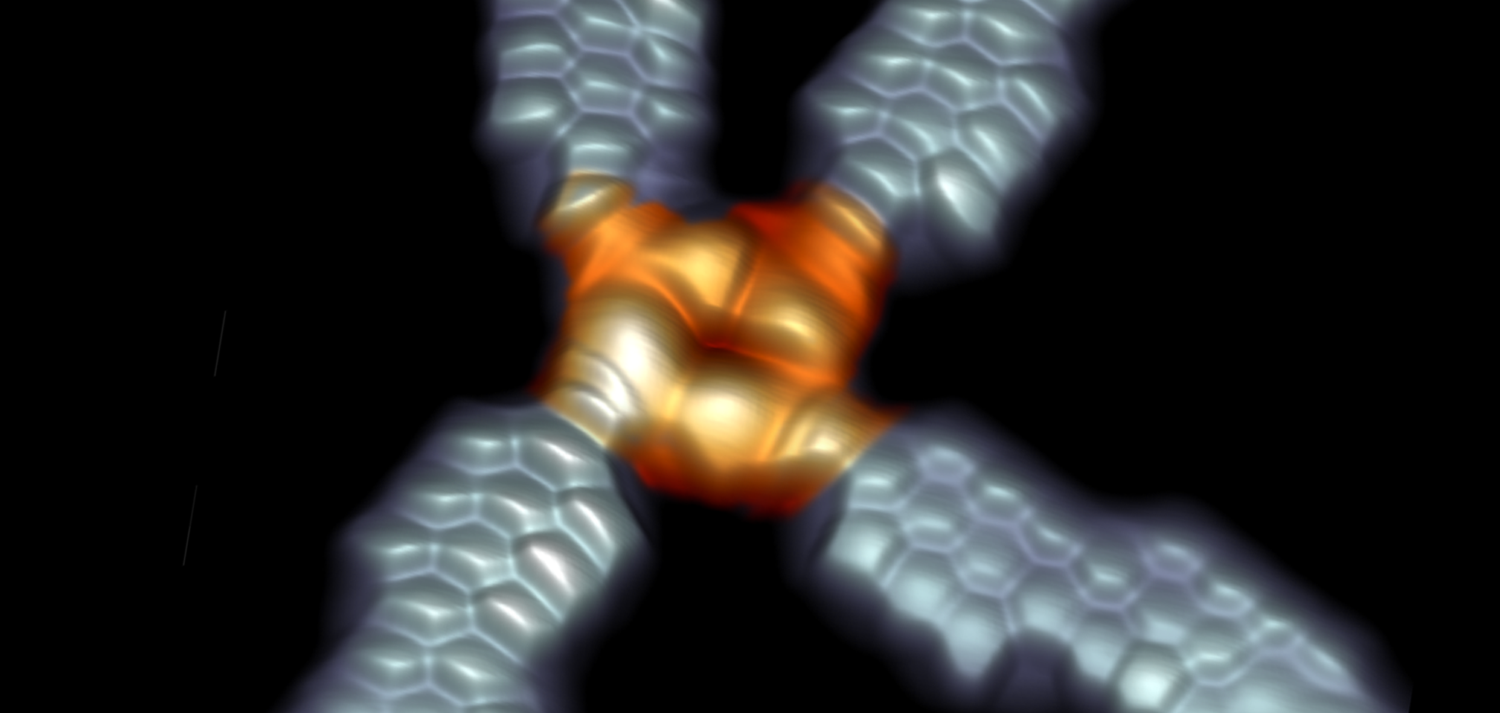
“The idea is fascinating: to store information into a single molecule and read it”, says Nacho Pascual, Ikerbasque Professor and leader of the Nanoimaging Group at nanoGUNE. “We have known for long time how to make the molecules, but we could never wire them into a circuit until now”, he confides. To achieve this goal, scientists developed graphene narrow stripes with the aim of using them as electrical wires; in addition, they also designed a method to precisely contact the molecule at predefined places.
“We found that the contact to the molecule crucially affects how the molecular device behaves”, says Jingcheng Li, first author of the article. “This discovery has made us direct the contacting step with atomic precision technologies”.
Regarding the molecule creation process, researchers have employed in this case a chemical method based on guided chemical reactions over a metallic surface. “The creation of the molecular device is simple”, explains CiQUS team leader, Diego Peña: “we designed and synthetized the building blocks with ‘glue-like’ chemical terminations at the points where contacts are to be created; from then on, nature does the rest of the job for us”, he jokes.
To illustrate the process, this group of scientists has given a very visual metaphor: “we can see it as a molecular LEGO”, they said. In words of Dr. Pascual, “we are learning how to use nature’s laws for assembling molecules into more complex nanostructures”, he claims.
The authors demonstrated the working function of the molecular device using Scanning Tunneling Microscopy (STM), a very advanced method to visualize atoms and molecules, and to measure their behavior. By means of this tool, they could confirm under which conditions the magnetic information stored in the molecule could survive to the contact, opening a new way to develop novel materials for efficient electronics.
The work has been realized in the framework of a Spanish collaborative research consortium named FunMolDev (acronym of Functional Molecular Devices), funded by the Spanish Ministry for the Economy and Competitiveness, the Government of the Basque Autonomous Community, the Xunta de Galicia, and the European Union.

